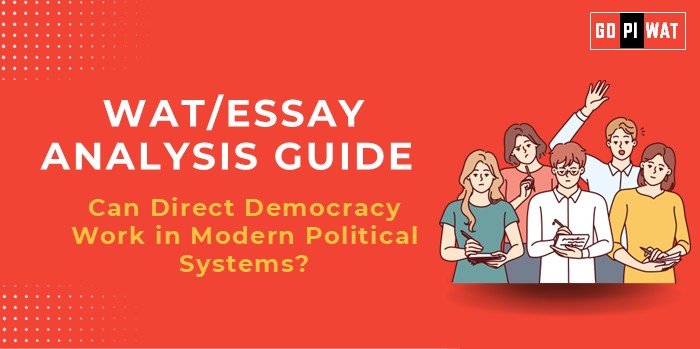📋 Essay Analysis Guide: Can Direct Democracy Work in Modern Political Systems?
🌐 Understanding the Topic
Direct democracy empowers citizens to make policy decisions directly. While countries like Switzerland demonstrate its potential, technological and logistical advancements raise the question of its feasibility in complex modern societies.
📝 Effective Planning and Writing
- ⏱️ Time Allocation:
- Planning: 5 minutes.
- Writing: 20 minutes.
- Review: 5 minutes.
- 📋 Structure:
- Introduction: 60 words.
- Body: 350 words.
- Conclusion: 60 words.
💡 Introduction Techniques for Essays
- ⚖️ Contrast Approach: “Switzerland’s successful referendums highlight the strengths of direct democracy, yet challenges like digital divides pose barriers to broader adoption.”
- 💡 Solution-Based Approach: “Technological advancements make direct democracy feasible, but ensuring inclusivity and security is essential for its success.”
📚 Structuring the Essay Body
🏆 Achievements
- ✅ Switzerland: 2023 referendums showcase direct democracy in action.
- 🌍 India: Gram panchayats engage 50 crore rural citizens, offering a large-scale model.
⚠️ Challenges
- 📉 Address digital and educational divides to ensure inclusivity.
- ⚖️ Prevent populism and misinformation from skewing outcomes.
🔮 Future Outlook
- 🌐 Propose hybrid systems combining direct and representative governance.
📄 Concluding Effectively
- ⚖️ Balanced Perspective: “While direct democracy enhances civic engagement, its success depends on overcoming digital and educational barriers.”
- 🌍 Global Comparison: “By learning from Switzerland and India, hybrid models could adapt direct democracy to modern political systems.”
📊 Analyzing Successes and Shortcomings
🌟 Key Successes
- ✅ Increased policy engagement.
- 🔧 Scalable technological solutions.
⚠️ Ongoing Challenges
- 📉 Digital and civic education gaps.
- ⚠️ Manipulation risks such as misinformation.
🌍 Global Context
- 🇨🇭 Switzerland and 🇮🇳 India as benchmarks for implementation.
✨ Recommendations for Sustainable Progress
- 🤖 Secure E-Voting Systems: Invest in robust, inclusive digital infrastructure.
- 📘 Civic Education: Ensure citizens are informed for meaningful participation.
- ⚖️ Hybrid Models: Combine direct democracy tools with representative governance for optimal results.
✍️ Sample Short Essays
⚖️ Balanced Perspective (100 words):
“Direct democracy enables transparency and engagement, as seen in Switzerland’s referendums. However, barriers like the digital divide and policy complexity make it impractical for larger nations. Hybrid systems that blend direct participation with representative governance may provide the most effective solution.”
💡 Solution-Oriented (100 words):
“Technological advancements like e-voting can revolutionize direct democracy, making it scalable for modern societies. To address risks of exclusion and misinformation, governments must invest in infrastructure, civic education, and robust safeguards, ensuring informed and equitable participation.”
🌍 Global Comparison (100 words):
“Switzerland exemplifies how direct democracy can thrive, while India’s gram panchayats show its potential at a grassroots level. By integrating technology and education, modern nations can adapt these models to enhance citizen participation without compromising governance efficiency.”


